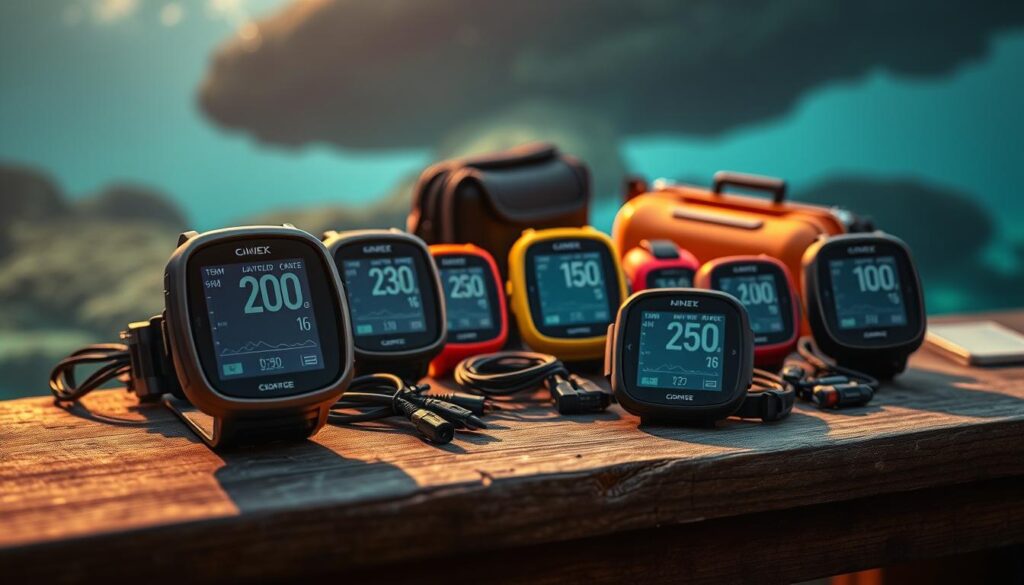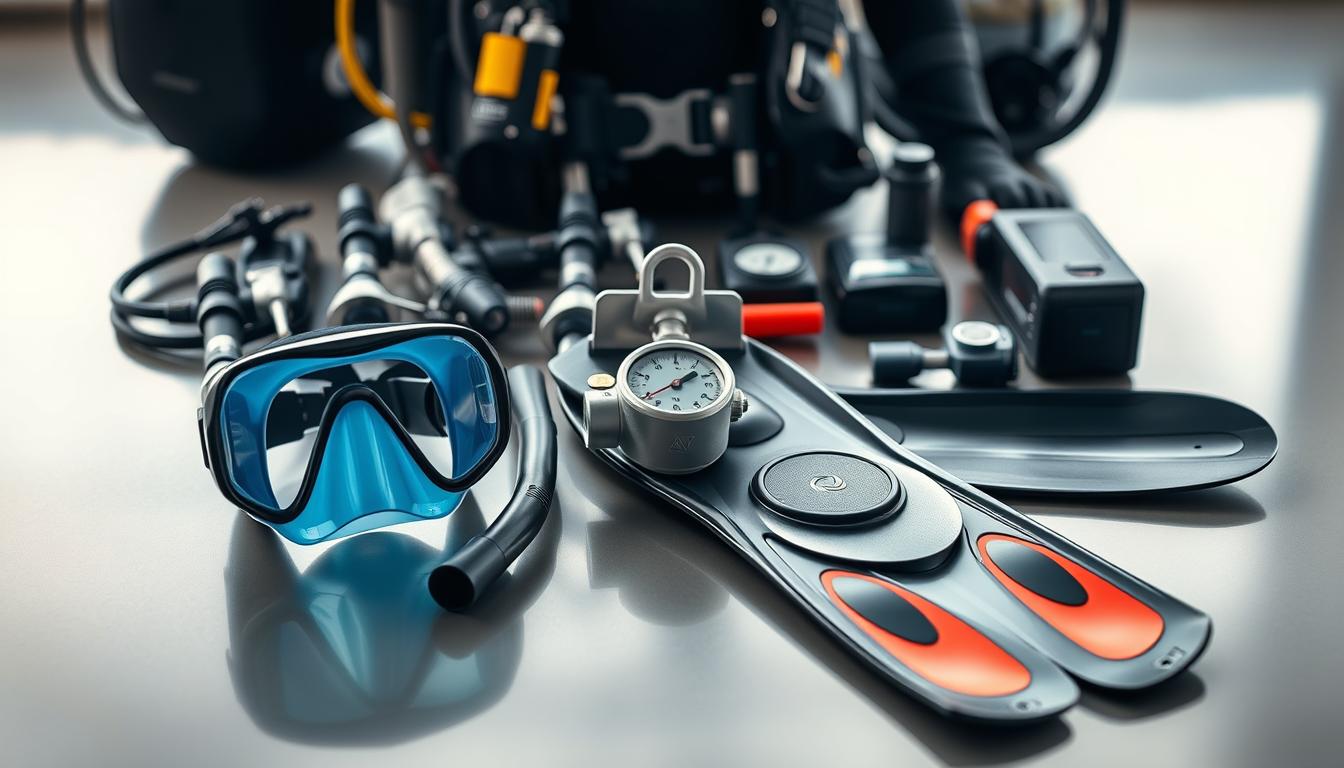To dive into the amazing underwater world, you need the right gear. Going into the blue tropical waters or the colder seas, having the right scuba gear is key. It keeps you safe and lets you enjoy your dive. This guide helps you pick the best snorkeling and scuba diving stuff. We focus on making sure your gear fits well and is comfortable and useful. We want you to be ready for any diving spot.
Key Takeaways
- Proper diving equipment is crucial for safety and enjoyment underwater.
- Choosing gear that fits well enhances comfort and functionality.
- Different environments require specific types of scuba diving gear.
- Understanding your equipment can enhance your overall diving experience.
- Maintain and care for your snorkeling gear to ensure longevity and performance.
Dive Mask: Your Window to the Underwater World
A essential item for clear vision underwater is a dive mask. It’s a key part of your gear. It lets you see the ocean’s colors and find your way around underwater.
Choosing the Right Dive Mask
Picking the best dive mask is important. First, it should fit your face well to keep water out. Masks with a soft silicone rim are great for comfort and a tight seal. They should also give you a big view around you.
Choose masks that are easy to clear and manage air with. Look for ones with straps you can adjust easily, even with gloves.
Maintaining Your Dive Mask
To keep your mask in top shape, clean it after each dive. Use fresh water to wash off salt and sand. Don’t use strong cleaners as they can harm your mask.
Keep your mask in a cool, dry spot away from the sun. This helps it last longer. Doing this keeps your view clear and comfy for many dives.
The Importance of Fins for Efficient Movement
Fins are a key part of scuba diving gear. They help you move smoothly under the water. Picking the right fins and using them well can help you avoid getting tired. It also makes your dive more enjoyable.
Types of Fins
There are two main types of fins: open-heel and full-foot. Open-heel fins can adjust to fit your foot. They are great for cold water. Full-foot fins fit right on your foot and are good for warm water.
Selecting the Right Fins
Picking the right fins involves a few important things. You need to think about how they fit, how hard the blade is, and if they feel good on long dives. Good fitting fins that push you forward will keep your energy up. This makes your dive better.
Wetsuits and Drysuits: Staying Warm and Protected
Jumping into underwater adventures, it’s key to know wetsuits from drysuits. Each keeps divers warm and safe in different waters.
Choosing Between a Wetsuit and a Drysuit
Wetsuits are made of neoprene, a kind of foam. They keep you warm by holding water that your body heats up. They’re good for warm or slightly cool waters. Drysuits, however, are for staying dry and are better for cold water activities like kayaking and fishing.
Drysuits use waterproof but breathable fabrics and are great for icy waters. Wetsuits and drysuits meet different needs based on the activity and water temperature.
Best Materials for Thermal Protection
Neoprene is often used in wetsuits for its warmth. It has tiny bubbles that insulate well. Wetsuit thickness ranges from 2mm to 8mm, with thicker ones being warmer. Drysuits, however, rely on special waterproof materials for staying dry in freezing waters.
Choosing quality gear matters for comfort and staying warm. Picking the right equipment makes diving safe and fun.
Fit and Comfort Tips
Getting the right fit is crucial for both wetsuits and drysuits. Wetsuits need to be tight but also let you move freely. A good fit keeps you warmer by keeping water out.
Drysuits should let you wear clothes underneath and stop water from getting in. Both suit types are essential for keeping warm and safe. Your choice should reflect where and how you plan to dive.
Buoyancy Control Device (BCD): Mastering Buoyancy
A buoyancy control device, or BCD, is very important for scuba diving. It helps divers stay neutral underwater. By putting air in the BCD, divers can go up or down easily. This makes the BCD a great tool for all divers.
Features to Look for in a BCD
When you pick a BCD, think about these things for the best use and comfort:
- Lift Capacity: Make sure the BCD can lift your weight and fits the diving you do.
- Fit: A good BCD fits well but lets you move and breathe easily.
- Ease of Use: Choose a BCD that is easy to use and doesn’t drag in the water.
Tips for Using a BCD Effectively
To use a BCD well, remember these tips:
- Practice using the BCD in a safe place to learn how to adjust the air in it.
- Always check and care for your BCD to make sure it works right when you dive.
- A BCD that fits you well makes moving underwater easier and helps you control your buoyancy.
Focus on these features and tips to make diving better. You’ll manage your buoyancy well under the water.
Diving Regulators: Breathing Made Easy
Diving regulators make sure divers get air from their tanks. This gear is crucial for a safe, fun dive.
Components of a Regulator System
A regulator system has many parts that work together. The first stage, attached to the tank, lowers the air’s high pressure. The second stage makes it easy to breathe.
There are also hoses linking the regulators to the tank and mouthpiece. Plus, gauges show tank pressure and depth. These help you watch your air and stay safe while diving.
Maintenance Tips for Regulators
It’s important to keep diving regulators working well. Check often for wear and clean them well after saltwater dives. This stops salt and rust from building up.
Get a pro to check your regulator every year. This checkup keeps everything working right. Taking good care of your gear means better dives every time.
Dive Computers: Staying Within Safe Limits
Dive computers are a must-have for scuba diving lovers. They keep track of important things like how deep you go, how long you stay, how quickly you come up, and how much nitrogen your body absorbs. This helps divers stay safe and avoid decompression sickness.

Dive computers give you data in real-time. This is super important whether you’re diving in a place you know well or a new spot. They are key for safety.
Today’s dive computers come with cool features. They make diving better and keep you safe. They are easy to use, letting divers keep an eye on their dive details without a fuss.
When picking a dive computer, think about what you need. Some are for more technical diving, others are great for just having fun. It’s important to choose one that works well with your other dive gear. This makes sure you have a good and safe dive.
Diving Equipment: From Surface Marker Buoy to Dive Bags
For divers, having the right scuba equipment is key. This includes Surface Marker Buoy (SMB) and tough dive bags.
The Surface Marker Buoy makes you seen when on top of the water. It’s needed in busy spots or during safety stops. It tells boats and other divers where you are, making things safer. SMBs have different styles. Some have shiny strips and devices to send signals.
Dive bags are just as crucial. They keep your scuba equipment safe. This includes fins, masks, and wetsuits. These bags are strong and can handle rough use. They have special spots for each piece of gear. You can find big bags on wheels or small ones for quick trips. There are many types to meet every diver’s need.
Each scuba equipment piece matters a lot for diving. This goes from Surface Marker Buoy to big dive bags. Picking good quality gear and taking care of it makes diving fun and safe.
Underwater Accessories: Enhancing Your Dive Experience
Having the right gear makes underwater adventures better. These tools help keep you safe and let you see clearly. Let’s look at must-have safety tools and lights for a great and safe dive.
Essential Safety Tools
Dive knives and emergency whistles are key for safety. Knives can free you from nets or lines quickly. Whistles can get you help when you need it. Together, they help make sure your dive is safe and smooth.
Lighting Solutions for Night and Cave Dives
Good lights are a must for dark dives. They light up night or cave explorations. This lets divers enjoy the beauty of the ocean, even in the dark. Lights keep divers safe and make the underwater world visible.
Conclusion
This guide has shown you important dive gear for safety and fun. You learned about dive masks, fins, and wetsuits. Each item is vital for a good dive.
It’s important to buy good gear like buoyancy devices and regulators. The right Buoyancy Control Device (BCD) helps manage how you float. A good regulator makes breathing underwater easy. Dive computers track your dive time and depth. Lights can make diving in dark places better.
Choosing the right dive gear makes your underwater trips better and safer. Keeping your gear in good shape is also key. This lets you enjoy the sea world to the max.
